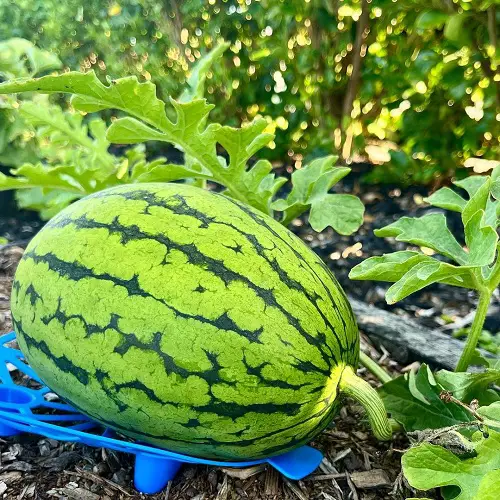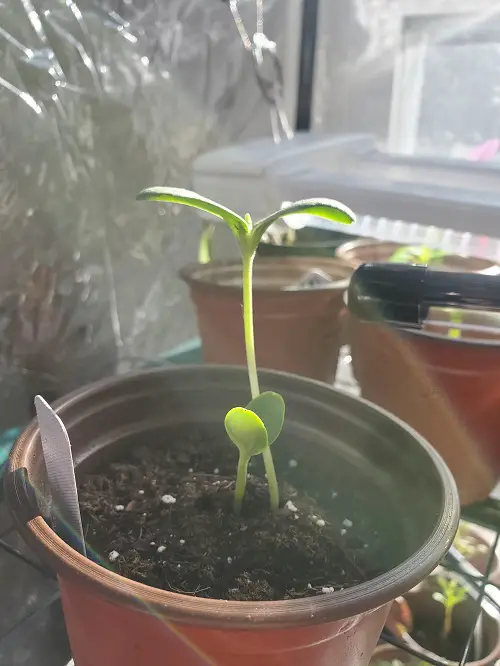Here’s a step by step guide on How to Grow Watermelons from Seeds in the easiest way! Try it today!

If you have no idea on how to grow watermelon from seeds, well, let us come to your rescue! This easy guide will tell you when to sow them in warmer or colder zones precisely to get 100% successful germination!
Best Watermelon Varieties to Grow From Seeds
- Crimson Sweet: Classic variety with deep red, sweet flesh.
- Sugar Baby: Compact, early-maturing variety for containers.
- Charleston Gray: Heirloom variety with large, oblong fruits.
- Jubilee: These have a sweet, crisp, and flavorful flesh.
- Black Diamond: A classic variety with almost black rind.
- Sangria: A seedless fruit with a crisp texture and sweet flavor.
- Crimson Tide: Popular for its disease resistance and high-quality fruit.
Can You Plant Watermelon Seeds Straight From the Fruit?
Do note that not every seed is capable of germinating and for that, you need to do a seed viability test (Put them in a bowl of water. The ones that float are not good. The ones that sink are good to go!). You can also take a chance of sowing multiple of them together.
Also, if you have taken them from fruits, it is no guarantee that the fruit from them will be of the same variety from which they are taken from.
The best is, get a packet from a garden centre, or online, to be sure!
When to Plant Watermelon Seeds?

Look for a soil temperature between 75°F to 95°F (24°C to 35°C) for best germination.
1. USDA Zones 3-6 (Cold Climate)
In these regions, the temperature might be extreme, so you have only one option—planting seeds indoors, about 4-6 weeks before the last expected frost date in your area.
Once the weather warms up, you can transplant the seedlings in the garden.
2. USDA Zones 7-9 (Moderate Climate)
This is somewhat the climate these fruits love, so you can plant their seeds in the garden after the frost, typically in spring or early summer.
3. USDA Zones 9b-11 (Hot Climate)
As the weather can be quite warm in these regions, you can start sowing watermelon seeds as early as mid to late winter, usually from mid-February to early March.
How to Grow Watermelon from Seeds?

Once you have gathered the seeds, it’s pretty much a straightforward process.
If you are growing them in the garden, pick a spot that gets plenty of sunlight (6-7 hours minimum). Amend the soil with compost for improved drainage.
Now, the planting process. Sow the seeds, and water using a spraying bottle to avoid disturbing their placement.
Also, if you are growing multiple seeds in the garden, space them at least 6-7 feet apart.
Once the seeds germinate (typically within 6 to 12 days. Remove weaker plants, leaving the healthiest ones), it is important that you water them right, moistening the soil when it goes a little dry at the top 1 inch.
If you want to learn about the watermelon growing stages in detail, we have a fantastic article on it.
Some Quick Tips to Make Watermelon Seeds Germinate Faster!
1. Sow them at the Right Depth
Sow the seeds about 1/2 to 1 inch (1.25 to 2.5 cm) deep in the the growing medium – this speeds up the germination process as the seeds get a good contact with the moist soil, essential for moisture absorption needed to trigger germination.
2. Soak them Up!
Soak watermelon seeds in a bowl of water for 12-16 hours. Do not exceed this limit, as anything excess of it can make them rot. This will soften up their outer layer, making germination easy and faster!
Growing Watermelon from Seeds in Pot

The sowing process is the same as above—you just need to get the right container size, which is at least 12-18 inches in size, with drainage holes at the bottom.
For pots, it will be a good idea to combine peat moss or coco coir (50%) along with perlite or vermiculite (30%) and compost (20%). Here, you have your own seed starting mix that you can easily make at home! Add a handful of worm castings and you are done!
It is also important that you pick varieties that are small, which will make the pot-growing process easy. You can go for the seeds of ‘Mini Love,’ ‘Bush Sugar Baby,’ ‘Little Baby Flower,’ or ‘Tiger Baby.’ All these remain manageable in containers and provide a juicy harvest!


